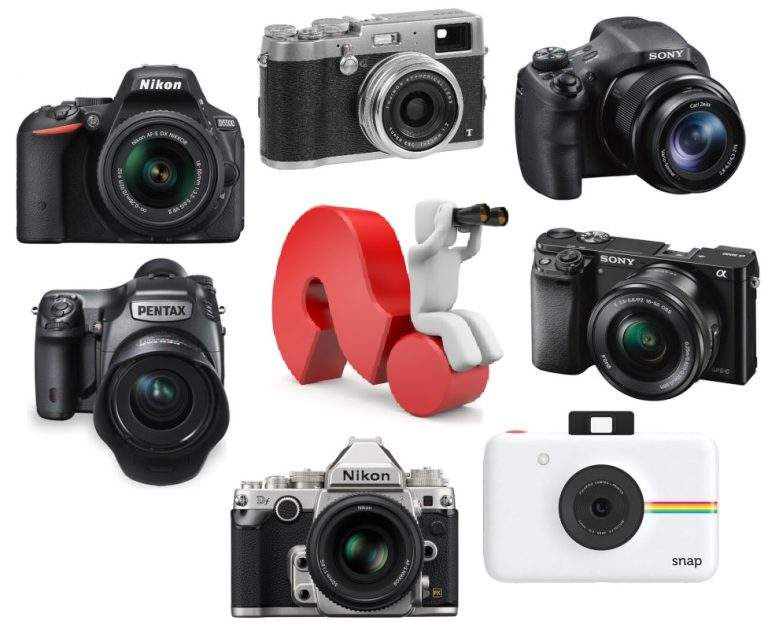There are many types of cameras available, each with their own set of features and capabilities. Some common types include:
- Digital single-lens reflex (DSLR) cameras: These cameras have a mirror and prism system that directs light from the lens to the viewfinder, allowing the user to compose and focus the image. They are often used by professional and serious amateur photographers.
- Mirrorless cameras: These cameras also have a digital image sensor and interchangeable lenses, but they do not have a mirror and prism system. Instead, the image is composed and focused using the camera’s electronic viewfinder or LCD screen.
- Point-and-shoot cameras: These cameras are small, portable, and easy to use. They typically have a fixed lens and a variety of automatic settings to help the user take pictures.
- Action cameras: These cameras are designed to be rugged and durable, and are often used for activities such as sports and adventure travel. They can be mounted on helmets, bicycles, and other equipment.
- Smartphone cameras: Many smartphones now have high-quality cameras built in, allowing users to take pictures and videos easily.
There are many other types of cameras as well, such as medium format, instant film, and more.
evaluating cameras
When evaluating cameras, there are several factors to consider, including:
- Image quality: This is determined by the camera’s sensor size, resolution, and dynamic range. A larger sensor with higher resolution and a wider dynamic range will generally produce better image quality.
- Lens quality: The quality of the lens will have a significant impact on the sharpness and clarity of the images. Look for a lens with a low f-stop (wide aperture) for low-light photography and shallow depth of field.
- Autofocus: This determines how quickly and accurately the camera can focus on a subject. Look for a camera with fast and accurate autofocus, especially if you plan to take pictures of moving subjects.
- Shutter speed: This determines how quickly the camera can take a picture. A faster shutter speed can be useful for freezing action and reducing blur.
- ISO: This determines how sensitive the camera’s sensor is to light. A higher ISO allows for better low-light photography, but can also introduce noise into the image.
- Video capabilities: If you plan to use the camera for videography, look for a camera with high resolution, good autofocus, and the ability to shoot in different frame rates.
- Battery life: A camera with a long battery life is essential if you plan to take a lot of pictures or shoot a lot of video.
- Ergonomics and design: The camera’s design, buttons and layout should be comfortable for you to hold and use.
- Price: Cameras can vary greatly in price, so it’s important to set a budget and consider what features are most important to you.
Ultimately, the best camera for you will depend on your specific needs and preferences.
Some other factors to consider are waterproofness, connectivity and storage options, and weight.
DSLR camera’s technology
Digital Single-Lens Reflex (DSLR) cameras are a type of camera that uses a mirror and prism system to direct light from the lens to the viewfinder, allowing the user to compose and focus the image. They have been around for quite some time and have evolved over time with the technology. The technology in DSLR cameras includes:
- Image sensors: DSLR cameras typically have larger image sensors than other types of digital cameras, which allows for better image quality and low-light performance. The most common type of image sensor used in DSLRs is the CCD (charge-coupled device) or CMOS (complementary metal-oxide-semiconductor) sensor.
- Autofocus: DSLR cameras use a variety of autofocus systems to quickly and accurately focus on a subject. The most common types are phase-detection and contrast-detection. Phase-detection autofocus uses a separate sensor to determine the distance to the subject, while contrast-detection autofocus analyzes the image on the sensor to determine the correct focus.
- Image processing: DSLR cameras use advanced image processing algorithms to improve the quality of the images. This can include noise reduction, color correction, and other adjustments.
- Interchangeable lenses: One of the key features of DSLR cameras is the ability to use interchangeable lenses. This allows the user to choose from a wide variety of lenses for different shooting situations.
- Connectivity: DSLR cameras now usually have built-in WiFi and Bluetooth connectivity, allowing users to transfer images to a smartphone or tablet, remotely control the camera, and share their images online.
- Video: Many DSLRs now can shoot 4K video and high-speed video, which allows more creative options for videographers.
- Durability: DSLRs are typically built to withstand a lot of wear and tear, and are designed to be rugged and durable.
Overall, DSLR cameras are known for their high image quality, advanced features, and flexibility. They are often used by professional and serious amateur photographers, but can also be a good choice for anyone who wants a camera with more advanced features and capabilities.
Mirrorless camera’s function & technology
Mirrorless cameras, also known as mirrorless interchangeable-lens cameras (MILC), are a newer type of digital camera that have many of the same features and capabilities as a DSLR camera, but without the mirror and prism system. Instead, the image is composed and focused using the camera’s electronic viewfinder or LCD screen.
The main functions of a mirrorless camera include:
- Image capture: Like a DSLR, a mirrorless camera uses a digital image sensor to capture light and create an image.
- Interchangeable lenses: Like a DSLR, a mirrorless camera allows the user to change lenses to adapt to different shooting situations.
- Autofocus: A mirrorless camera uses a variety of autofocus systems, including phase-detection and contrast-detection, to quickly and accurately focus on a subject.
- Image processing: A mirrorless camera uses advanced image processing algorithms to improve the quality of the images.
- Video recording: Many mirrorless cameras can shoot high-quality video, including 4K and high-speed video.
The technology in mirrorless cameras includes:
- Electronic viewfinder (EVF): Instead of using a mirror and prism system to direct light to the viewfinder, a mirrorless camera uses an electronic viewfinder (EVF) which shows a live preview of the image on the camera’s sensor.
- Image sensor: Mirrorless cameras typically use either a CCD or CMOS sensor, like DSLRs.
- Faster autofocus: Because mirrorless cameras use a different autofocus system, they tend to focus faster than DSLR cameras.
- Smaller size and weight: Because mirrorless cameras do not have the mirror and prism system of a DSLR, they tend to be smaller and lighter than DSLRs.
- Connectivity: Many mirrorless cameras now have built-in WiFi and Bluetooth connectivity, allowing users to transfer images to a smartphone or tablet, remotely control the camera, and share their images online.
Overall, mirrorless cameras offer many of the same features and capabilities as a DSLR, but in a smaller and more compact package. They are becoming increasingly popular among professional and serious amateur photographers, as well as anyone looking for a camera with advanced features and capabilities.
Point-and-shoot cameras
Point-and-shoot cameras, also known as compact cameras, are small, portable, and easy-to-use cameras that typically have a fixed lens and a variety of automatic settings to help the user take pictures. They are designed to be user-friendly and are a good choice for people who want a camera that is easy to use and can be carried around easily.
The main functions of a point-and-shoot camera include:
- Image capture: Like other types of cameras, a point-and-shoot camera uses a digital image sensor to capture light and create an image.
- Automatic settings: Point-and-shoot cameras often have a variety of automatic settings, such as auto-exposure and auto-focus, which make it easy for the user to take pictures without having to worry about manual settings.
- Zoom: Many point-and-shoot cameras have a built-in zoom lens, which allows the user to zoom in and out to change the focal length of the lens.
- Video recording: Many point-and-shoot cameras can also record video.
The technology in point-and-shoot cameras includes:
- Small size and weight: Point-and-shoot cameras are designed to be small and lightweight, making them easy to carry around.
- Fixed lens: Point-and-shoot cameras typically have a fixed lens, which means that the lens cannot be changed.
- Automatic settings: Point-and-shoot cameras often have a variety of automatic settings, such as auto-exposure and auto-focus, which make it easy for the user to take pictures without having to worry about manual settings.
- Connectivity: Some point-and-shoot cameras now have built-in WiFi and Bluetooth connectivity, allowing users to transfer images to a smartphone or tablet, remotely control the camera, and share their images online.
- LCD screen: Most point-and-shoot cameras have an LCD screen that allows the user to preview and review images.
Overall, point-and-shoot cameras are designed to be easy to use, and are a good choice for people who want a camera that is small and easy to carry around. They are also a great option for people who want a camera that is easy to use and does not require much technical knowledge.
action camera
Action cameras, also known as sports cameras, are small, rugged and durable cameras that are designed to be mounted on helmets, bicycles, and other equipment. They are often used for activities such as sports, outdoor activities, and adventure travel. They are known for their durability and ability to capture high-quality video and images in challenging environments.
The main functions of an action camera include:
- Image and video capture: Action cameras can capture high-quality images and video in a variety of resolutions, including 4K and high-speed video.
- Waterproof and rugged design: Action cameras are designed to be waterproof and rugged, allowing them to withstand a wide range of temperatures and environmental conditions.
- Mounting options: Action cameras come with a variety of mounting options, such as adhesive mounts and clips, which allow the camera to be attached to helmets, bicycles, and other equipment.
- WiFi and Bluetooth connectivity: Many action cameras have built-in WiFi and Bluetooth connectivity, allowing users to transfer images and videos to a smartphone or tablet, remotely control the camera, and share their images online.
- Image stabilization: Some action cameras come with image stabilization technology to help reduce camera shake and blur.
The technology in action cameras includes:
- Image sensors: Action cameras typically use small image sensors, which allows them to be small and lightweight.
- Wide-angle lenses: Action cameras often have wide-angle lenses, which allows them to capture a wide field of view.
- Waterproof and rugged design: Action cameras are designed to be waterproof and rugged, allowing them to withstand a wide range of temperatures and environmental conditions.
- WiFi and Bluetooth connectivity: Many action cameras have built-in WiFi and Bluetooth connectivity, allowing users to transfer images and videos to a smartphone or tablet, remotely control the camera, and share their images online.
- Battery life: Action cameras often have a long battery life, which is essential for outdoor activities and sports.
Overall, action cameras are designed for people who want to capture high-quality images and videos in challenging environments, such as during outdoor activities, sports, and adventure travel. They are known for their durability, small size, and wide range of mounting options.
Smartphone camera
Smartphone cameras are cameras that are built into smartphones, which allow users to take pictures and videos easily. They have become increasingly popular in recent years, as the technology has improved and the quality of the images and videos produced by these cameras has become comparable to that of traditional point-and-shoot cameras.
The main functions of a smartphone camera include:
- Image and video capture: Smartphone cameras can capture high-quality images and video in a variety of resolutions, including 4K and high-speed video.
- Automatic settings: Many smartphone cameras have a variety of automatic settings, such as auto-exposure and auto-focus, which make it easy for the user to take pictures without having to worry about manual settings.
- Zoom: Many smartphone cameras have a built-in digital zoom, which allows the user to zoom in and out to change the focal length of the lens.
- Connectivity: Smartphone cameras have built-in WiFi and cellular connectivity, allowing users to transfer images and videos to other devices, remotely control the camera, and share their images online.
The technology in smartphone cameras includes:
- Image sensors: Smartphone cameras typically use small image sensors, which allows them to be small and lightweight.
- Wide-angle lenses: Smartphone cameras often have wide-angle lenses, which allows them to capture a wide field of view.
- Automatic settings: Many smartphone cameras have a variety of automatic settings, such as auto-exposure and auto-focus, which make it easy for the user to take pictures without having to worry about manual settings.
- Connectivity: Smartphone cameras have built-in WiFi and cellular connectivity, allowing users to transfer images and videos to other devices, remotely control the camera, and share their images online.
- Image processing: Smartphone cameras use advanced image processing algorithms to improve the quality of the images.
Overall, smartphone cameras are a convenient and easy-to-use option for people who want to take pictures and videos easily. They have become increasingly popular in recent years, as the technology has improved and the quality of the images and videos produced by these cameras has become comparable to that of traditional point-and-shoot cameras.













